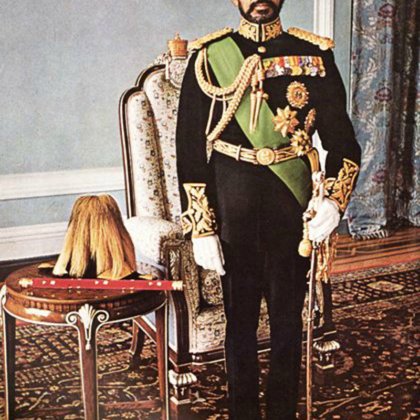THE ETHIOPIAN EMPEROR HAILE SELASSIE (1930 - 1974),HE WAS A MEMBER OF SOLOMONIC DYNASTY.THE LAST EMPEROR IN THE 3000 - YEAR - OLD ETHIOPIAN MONARCHY,WHO RULED FOR HALF A CENTURY BEFORE HE WAS DEPOSED BY MILITARY COUP.
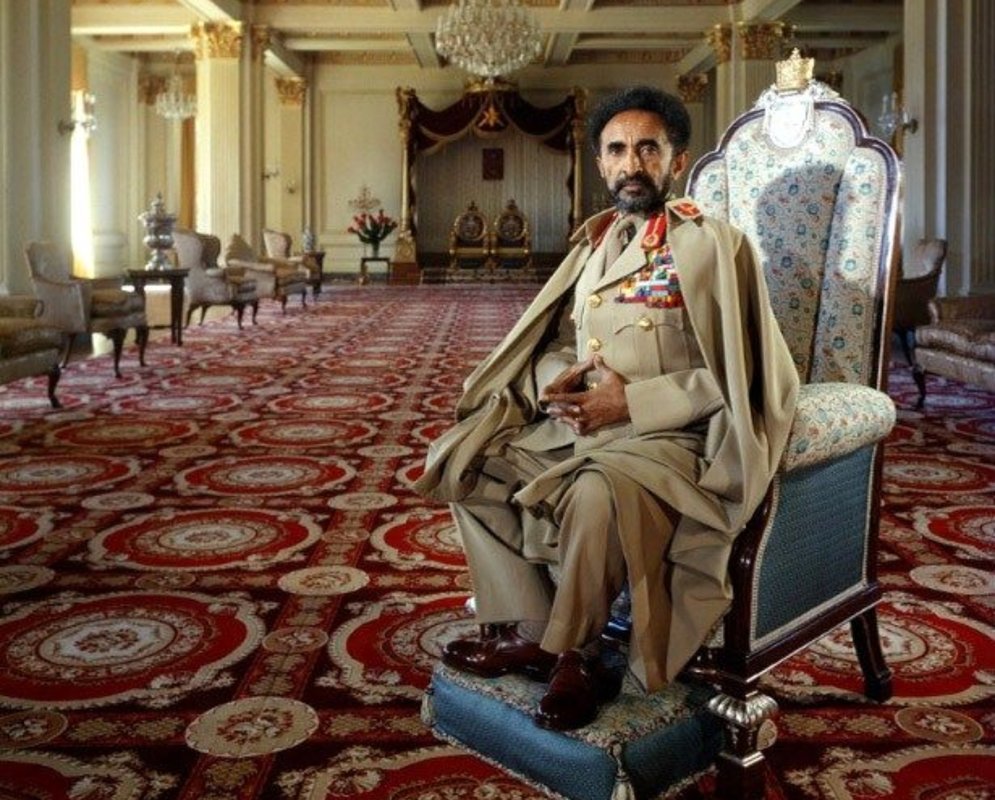 Haile Selassie I was
Ethiopia’s 225th and last emperor, serving from 1930 until his
overthrow by the Marxist dictator Mengistu Haile Mariam in 1974. The
longtime ruler traced his line back to Menelik I, who was credited with
being the child of King Solomon and the Queen of Sheba.
Haile Selassie I was
Ethiopia’s 225th and last emperor, serving from 1930 until his
overthrow by the Marxist dictator Mengistu Haile Mariam in 1974. The
longtime ruler traced his line back to Menelik I, who was credited with
being the child of King Solomon and the Queen of Sheba.
Haile Selassie was born near Harar, Ethiopia on July 23, 1892. His name at birth was Tafari Makonnen. Ras ("prince") Tafari displayed keen intellectual abilities early in his studies, and by the age of fourteen was appointed provincial governor. Upon his coronation as emperor of Ethiopia in 1930, he took the name Haile Selassie, which means "might of the trinity." He was also granted the title "Conquering Lion of the Tribe of Judah, Elect of God and King of the Kings of Ethiopia." Haile Selassie fled his country while in exile for a time during World War II. In 1941 he returned to power in Ethiopia. Early in his rule, he was considered a progressive reformer, who outlawed slavery and introduced educational, economic, and social reform s. He helped found the Organization of African Unity in 1963. However, as famine, economic depression, and the Eritrean crises worsened conditions in Ethiopia, he lost support. Selassie was deposed by military mutiny in 1974, and lived under house arrest until his death on August 26, 1975. In addition to having served as Emperor of Ethiopia from 1930 - 74, he is worshipped as a divine being by followers of the Afro - Caribbean Rastafarian religion .His mother was Yeshimbet Ali Abajiffar and his father was Ras (Duke) Makonnen Wolde Michael, Governor of Harrar, relative of Emperor Menelik II (1889-1913), and a former general who had played a key role in the 1896 Battle of Adowa where Ethiopia defeated an invading Italian Army to become the only African state to retain its independence by military action.His birth name given by his parents was Lij Tafari Makonnen. He was the only surviving son of the governor of Harar, Ras Makonnen Wolde Michael. Selassie traced his linage back to Menelik I, who was credited with being the child of King Solomon and the Queen of Sheba. He was raised a Christian and educated by private European tutors. His father passed on in 1906 and was taken under the wing of his uncle Menelik II who did not have a son to succeed him and SelassieI appeared to be the favoured successor.He spent his youth at the court of the emperor of Addis Ababa. He was exposed to political plots and learned about the use of power. The capacity of his memory, mastery of detail and hard work earned him the position of governor of Gara Muleta in the province of Harar at the age of fourteen. At the age of twenty Menelik II appointed him as commander of the extensive province of Sidamo.However his anticipated succession of Menelik II never took place as after the passing of Menelik II in 1913, his grandson Lij Yasu who was not a Tafari succeeded him. Yasu’s religion Islam cost him his leadership position as he maintained close ties with Islam in a Christian dominated country and he never gained favor with the Christian population. Selassie became the face of the opposition and later took power in 1916 and imprisoned Yasu for life. In 1917 Menelik II’s daughter Zauditu contested the throne and became empress and Selassie was named regent and heir to the throne.As the emperor he became a symbol of hopes and dreams of his country, trying to place his young country in the map. As leader his power increased, he led Ethiopia into the League of Nations in 1923 and by travelled to Europe, a first for an Ethiopian ruler in 1924. The empress showed less interest in politics but in religion, which was opposite to Selassie whose growing interest was in turning the country into a more modern one. He became stronger when he took control of the army in 1926, and this position allowed him to assume the title of king. In 1928 he became a self-proclaimed king and after the death of Zauditu in 1930 he demanded the title of King of Kings and took the name Haile Selassie (Might of the Trinity).The forty years of his power over the country and government led to him instituting a new constitution and centralizing his power. In 1935 his efforts were cut short when Benito Mussolini’s Italy invaded Ethiopia. He resisted the invaders with some of the feudal lords supporting him and others siding with the invaders. Selassie sent troops to Tigray in 1936, his army claimed a victory at the battle of Tembien, however the victory was short lived as the Italians overcame them by using mustard gas after the battle. The Ethiopian army retreated to Maychew and this was their final stand. Afterwards Ethiopia lost its national independence. The following year Selassie was forced into exile. The Ethiopians continue fighting the Italians by waging guerilla war. During the war he remained in exiled and banded his country together to fight the Italians. For aid he appealed to the League of Nations but was unsuccessful. He then went to British for help.
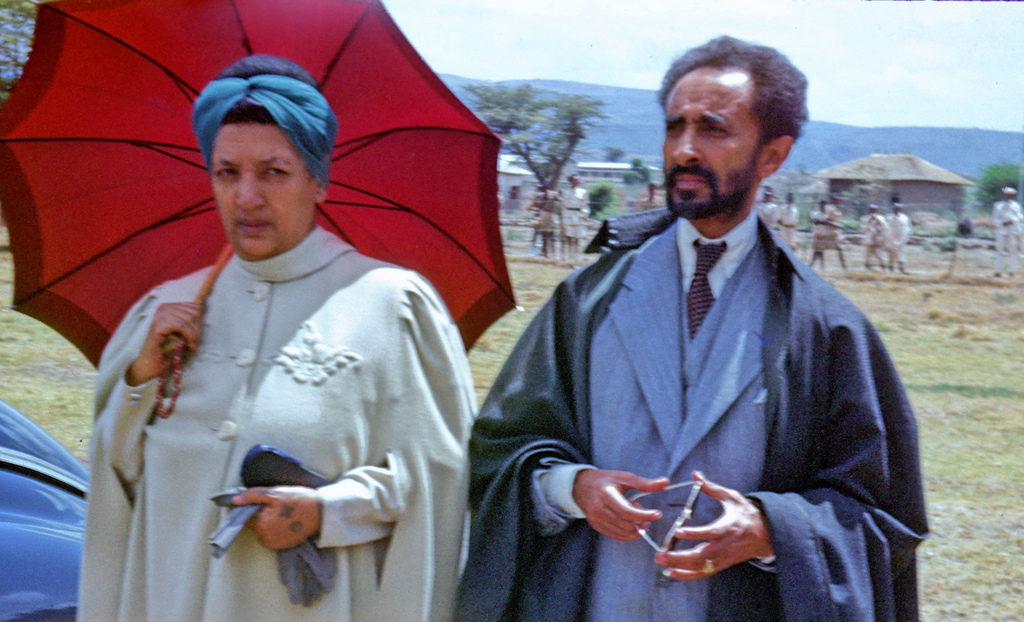 Haile Selassie (R) with his wife, Queen Menen.On the Emperor’s visit to Jamaica in 1966, The Guardian noted, a great crowd of Rastafarians surrounded the airport with banners showing the Ethiopian Lion of Judah.“Converging around the Ethiopian plane even as the propellers were turning, they sang praise to their god in human form, who they believed had come to redeem his Jamaican brethren,” it added.
Haile Selassie (R) with his wife, Queen Menen.On the Emperor’s visit to Jamaica in 1966, The Guardian noted, a great crowd of Rastafarians surrounded the airport with banners showing the Ethiopian Lion of Judah.“Converging around the Ethiopian plane even as the propellers were turning, they sang praise to their god in human form, who they believed had come to redeem his Jamaican brethren,” it added.
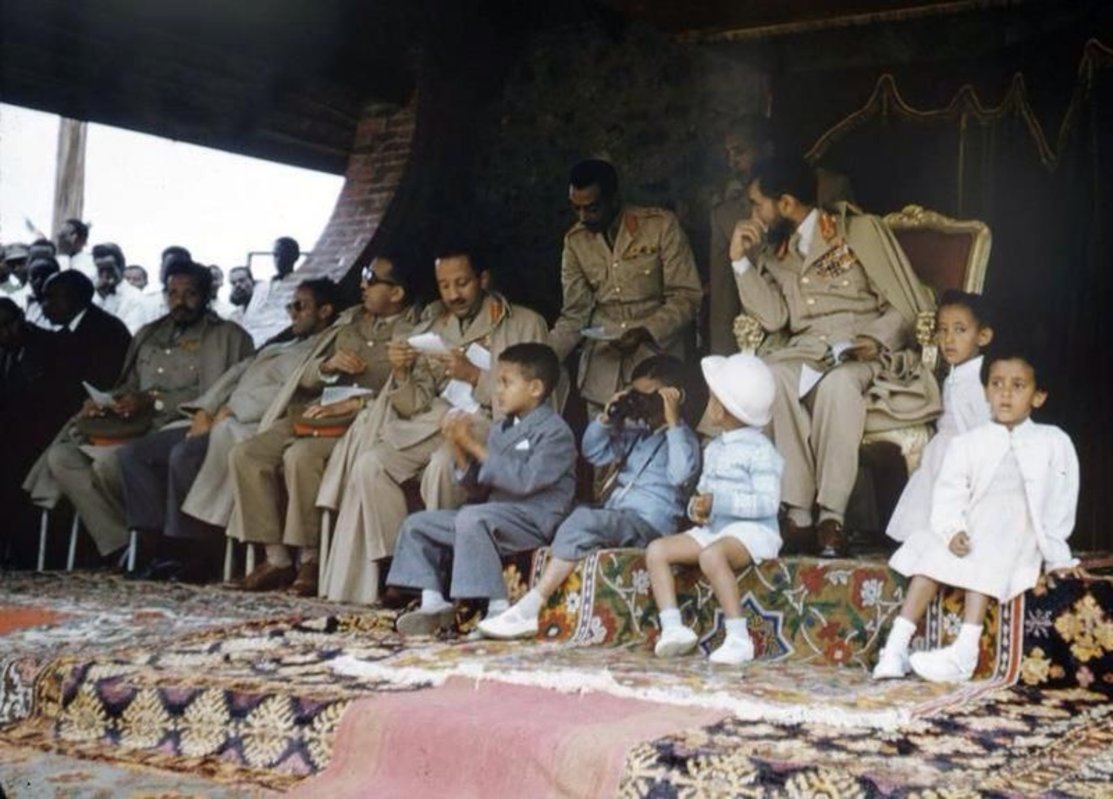 Addis Ababa, Ethiopia, Africa, 1954, Emperor Haile Selassie, the King of Abyssinia, and his family are pictured with L-R: Princesses Silvia (3), and Mary (4), daughters of the Crown Prince, Princes Michael (4), David (2) January 01, 1954.
Addis Ababa, Ethiopia, Africa, 1954, Emperor Haile Selassie, the King of Abyssinia, and his family are pictured with L-R: Princesses Silvia (3), and Mary (4), daughters of the Crown Prince, Princes Michael (4), David (2) January 01, 1954.
In 1941 the British finally came to his aid and freed the country from the Italian control. He returned to claim his throne. On his return to his country he found his administration destroyed. He dedicated himself to rebuild his administration and improving Ethiopia’s defense. Progressively many youngsters were sent to study abroad and learn what they could from other cultures. He improved the infrastructure of the country, and backed by the Western powers he managed to build bridges, hospitals, factories and schools. He was viewed as a reformer by many.Despite being a reformer he ruled with iron fist. He became paranoid about the partisans who had stayed behind and fought the Italians. He was intimidated by their bravery and decided to remove them from the position of authority and replaced them with those who collaborated with the enemy (Italians), because he knew that they could be kept easily in line and would be open to the methods of Selassie. His methods of maintaining power involved financial rewards and promotion of government officials. He gradually grew more cautious and allowed few new leaders into his new government. In 1962 he managed to absorb Eritrea into Ethopia.In Ethiopia all was not well. He suppressed political parties and opposition. Ethiopian peasants were starved while he was leaving a lavish lifestyle. Selassie was accused of breeding corruption and the creation of a system in which millions of his subject lived in poverty and oppression. People struggled to rebel with empty stomachs and this seemed to suit him. Media was censored and controlled by the emperor, and Western journalists were no longer allowed in the country. The suffering of his subject was finally exposed and caused great embarrassment to his reign. He exercised absolute control and punished those who questioned and undermined his authority, this led to attempt to a government coup in December 1960. The attempt failed and turned into a bloody massacre that sent a message to possible of plotters of what could happen to them.By the 1970s the situation in Ethiopia had worsened, with unemployment increasing, and government’s inability to respond to the country’s problems Selassie’s rule was undermined. He lost control over his army as many left the army over low pay. This weakened his defense and as the result he was ousted from power in a coup. He was kept under house arrest until his death in 1975.The cause of death was disputed; reports claimed he had died of natural cause but another one revealed that he had probably been strangled to death on governmental orders. His remains were discovered in 1992. He received a proper burial in November 2000 in Addis Ababa’s Trinity Cathedral. Appointed governor of Harrar Province, Tafari Makonnen, despite his descent from previous Emperors, would likely have remained an unimportant political figure had he not married his second wife, Menen Asfaw, niece to the heir of the Ethiopian throne, Lij Iyasu. When rumors spread that Iyasu was flirting with Islam, Ethiopian nobles made Tafari regent in 1916. Elevated to the rank of Ras, Tafari began to rule in fact while Empress Zewditu, the daughter of Emperor Menelik II, was official head of state. As regent Ras Tafari Makonnen began the transformation of Ethiopia. He ended slavery in 1923 and established a school for newly freed slaves in the capital, Addis Ababa. By ending slavery Selassie secured Ethiopia’s admission to The League of Nations. Selassie also began touring Europe both to acquire knowledge and assistance in his modernization efforts and to raise the profile of the only independent monarchy on the African continent.Ras Tafari Makonnen became Emperor outright in 1930 upon the death of Empress Zewditu. Upon assuming the throne, he took the name Haile Selassie meaning “Might of the Trinity.” Continuing his modernization of the state, Selassie in 1931 established the first Ethiopian constitution which centralized governmental power under his leadership. Selassie believed that a more powerful central government was necessary to carry out his modernization ideas for the nation’s bureaucracy, military, and economy. Selassie also focused his attention on increasing public health services, providing electricity, and creating a modern telephone network. In 1931 he founded the Bank of Ethiopia which introduced Ethiopian currency.Selassie’s ambitious programs were threatened by the imperial designs of Italian leader Benito Mussolini. Italy had already held Eritrea just north of Ethiopia and was looking to avenge its defeat at the Battle of Adowa in 1896.Without warning Italy invaded Ethiopia on October 3, 1935 and fought for seven months. Although the League of Nations named Italy the aggressor in the conflict, no further actions were taken. Italian forces easily defeated the Ethiopian Army forcing Halie Selassie and his family into exile in Great Britain on May 2, 1936. Soon afterwards, on June 30, 1936, he gave his most famous speech before the League of Nations, where he protested the use of chemical weapons against his people and decried the advent of the technological “refinement of barbarism.” Despite widespread praise of his speech and sympathy for the Ethiopian people, Western powers did not come to his assistance in the campaign against the Italians.Although the League failed to act, by 1939, Great Britain and France, now at war with Germany and Italy, came to Ethiopia’s aid. On May 5, 1941 Selassie re-entered Ethiopia with the assistance of South African, British, and Ethiopian soldiers. By January 1942 all Italian troops had been driven from the country. Haile Selassie accepted British military assistance. He did not, however, accept their political help in rebuilding Ethiopia, believing they intended to undermine his authority. Selassie become increasingly concerned about outside influences in his nation and slowed the modernization process he had initiated upon becoming Emperor. Ethiopia increasingly became an autocratic state isolated from much of the rest of the world community. Selassie devoted resources to controlling Eritrea which came under Ethiopian rule after World War II. His military rule of that region led to an independence campaign that triumphed finally on May 24, 1993. Despite his country’s poverty and political stagnation, Selassie viewed himself as a world leader. Ethiopia became a charter member of the United Nations in 1945. In 1950 he sent Ethiopian troops to fight under Allied command in Korea. Throughout the rest of the decade he traveled widely. In 1954, for example, he became the first head of state to visit newly independent West Germany. Nine years later, in 1963, he helped found the Organization of Africa Unity and built its headquarters in Addis Ababa. After visiting Jamaica in 1960, the Rastafarians, with thousands of supporters world wide, proclaimed him a living God. Selassie, however, seemed unable to control the growing political dissatisfaction over his reign which became even more pronounced by a series of crop failures and famines between 1972 and 1974 which killed 80,000 people and brought millions of Ethiopians to the brink of starvation. Two years later in 1974, after riots and hyperinflation paralyzed his government, the Derg, a committee of Army officers, deposed the Emperor and announced the end of the empire.
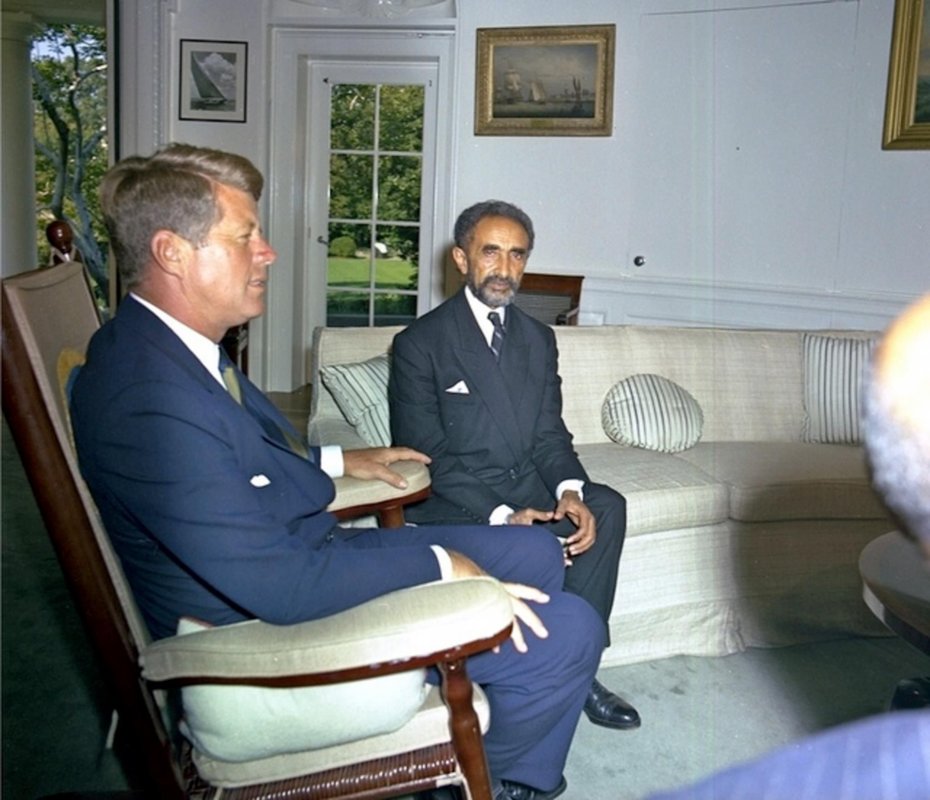
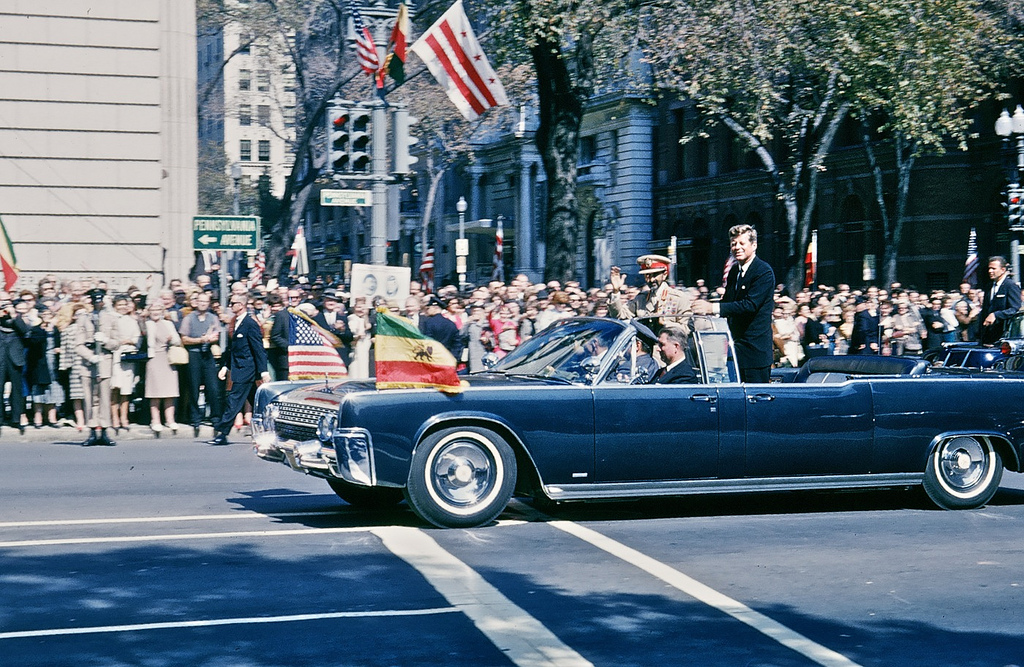 Haile
Selassie with U.S. President Kennedy .Haile Selassie is giving JFK Jr, a gift, which is a statue carved out of
ivory.President John F. Kennedy with Emperor of Ethiopia,
Haile Selassie I, following a farewell meeting. Also pictured: Imru
Haile Selassie, second cousin of Emperor Selassie; Minister of the
Imperial Court of Ethiopia.
Haile
Selassie with U.S. President Kennedy .Haile Selassie is giving JFK Jr, a gift, which is a statue carved out of
ivory.President John F. Kennedy with Emperor of Ethiopia,
Haile Selassie I, following a farewell meeting. Also pictured: Imru
Haile Selassie, second cousin of Emperor Selassie; Minister of the
Imperial Court of Ethiopia.
His death was played down by the military rulers who succeeded him in Addis Ababa, who announced it in a normally scheduled radio newscast there.They said that he had been found dead in his bed by a servant, and that the cause of death was probably related to the effects of a prostate operation Haile Selassie underwent two months ago. The broadcast said that the once-revered "Lion of Judah's" only surviving daughter, Princess Tenagnework, visited the former Emperor Tuesday at his request, after he had determined that his health was rapidly deteriorating. But in London, Crown Prince Asfa Wossen Haile Selassie, who has been living abroad since the leftist government in Ethiopia formally declared an end to the monarchy last March, said his father had been in "excellent health." In a written statement issued in London, it was said that "the Crown Prince demands that independent doctors and the International Red Cross be allowed to carry out an autopsy to ascertain the cause of death of Ethiopia's and Africa's father." Official sources said that burial of the former Emperor would be "in the strictest privacy." According to Ethiopian custom, burial must take place within 24 hours after death. As a symbol of regal power, His Imperial Majesty the Conquering Lion of the Tribe of Judah, Haile Selassie I, Elect of God, Emperor of Ethiopia, had ruled his ancient realm as a medieval autocrat. Seized in a military coup after almost a year of festering discontent with his regime, Haile Selassie, who was accustomed to Rolls-Royces, was hustled from his spacious palace to an army officer's bungalow in the back seat of a blue Volkswagen. The final confrontation between the aged and frail Emperor and the young and robust army men was like a scene from a Verdi opera. Haile Selassie scolded and insulted the officers as insolent, and they, with mounting ire, decided on the spot to take him to a military camp rather than to another palace. And on the way, he was jeered by crowds yelling: "Thief! Thief!" Haile Selassie.The combination of circumstances that led to Haile Selassie's downfall tended to obscure his accomplishments in leading a largely illiterate, rural and feudal country with 2,000 languages and dialects into the 19th, if not the 20th, century. And it also shadowed his contributions to African unity. An African who met the Emperor at the United Nations Security Council session in Addis Ababa in 1972 summed up a widespread feeling when he said:"Haile Selassie is one of the world's great men. He did a lot for his country and early became a respected voice for Africa and for the third world."If the pace of change was snailish under the Emperor, it was deliberately so. "We must make progress slowly so as to preserve the progress we have already made," he said frequently of his reign, in which slavery was legally abolished and limited democratic structures instituted.But he was also regarded as one who ruled too strictly by prerogative for the benefit of his family and friends. And at his ouster he was popularly accused as an exploiter who had secretly sent billions of dollars to private bank accounts abroad.The drama of his departure from power and the intrigues that preceded it were kin to the events of his long life.Coming to power in a palace coup and, later, discomfiting his enemies in battle, Haile Selassie was driven into exile by the troops of Fascist Italy after the civilized world had spurned his eloquent and poignant appeals for help.Restored to his capital in World War II, he obtained for Ethiopia a coastline on the Red Sea, skillfully courted foreign economic aid, strove to improve education, squashed an attempted coup and, despite the anachronisms of his person and the archaicisms of his country, emerged as an elder statesman of African anticolonialism.The prestige and power of Haile Selassie, waxing over more than a half century, made of him a personage larger than life. With a splendid sense of theater, he lived up to, and even surpassed, the role in which he was cast.Once the Emperor was distributing gifts to men who served the Ethiopian cause in World War II. After he had finished, one man approached him and complained that he had been overlooked."You lie," Haile Selassie replied, calling the petitioner by name and citing the exact place, day and hour that he had been rewarded for obtaining a string of mules for the army.The man flushed and trembled, for he had never suspected that the Emperor would remember, since scores of others had been honored at the same time. He started to inch away, but the Emperor summoned him back and tossed him a bundle of banknotes anyway.Such magnificent and munificent gestures tended to obscure the fact that the Emperor looked emaciated, and was only 5 feet 4 inches tall. But he managed to convey an imposing presence and an air of cold command whether he was seated at his desk in military uniform with a blazing array of decorations across his chest; or whether he was standing, caped, on the rostrum of the League of Nations; or whether, seated bolt upright in his green or maroon Rolls-Royce, he was motoring through the dusty streets of Addis Ababa as his subjects lay prostrate while he passed.What helped to make Haile Selassie so physically imposing was his bearded and dark- complexioned face, his aquiline nose over full lips and his steady, penetrating black eyes. It was a mien both melancholy and fearsome, the visage of one who ruled by the precepts of John Stuart Mill as well as by those of Niccolo Machiavelli, by compassion as well as cruelty; for he could be generous to loyal subordinates, or he could hang the rebellious, or he could keep a rival imprisoned in golden chains.The limit of his emotional expression was a sad smile, so enigmatic that his true feelings seemed deeply mysterious.To many in the West, especially in the United States, Haile Selassie was a storied figure. He was the 225th Emperor of Ethiopia in a line that he traced to Menelik I, who was credited with being the child of King Solomon and the Queen of Sheba, identified in Ethiopia as Queen Makeda. (The constitution of 1955 specified Haile Selassie's direct descent from Menelik I.)Unbending on protocol and punctilio, the Emperor, in his public appearances, recalled the splendor and opulence of Suleiman the Magnificent or Louis XIV, with the difference that he lived and worked in a modern atmosphere and journeyed abroad in a commandeered Ethiopian Airlines plane. He once had three palaces; but after he transformed the Gueneteleul Palace into the Haile Selassie I University in 1960, he was reduced to a palace to live in--the Jubilee--and one to work in--the Ghibi.Around the clock, he was guarded by lions and cheetahs, protected by Imperial Bodyguards, trailed by his pet papillon dogs, flanked by a multitude of chamberlains and flunkies and sustained by a tradition of reverence for his person. He took seriously the doctrine of the divine right of kings, and he never allowed his subjects to forget that he considered himself the Elect of God. Indeed, he combined in his person the temporal sovereignty of the state and the leadership of the Ethiopian Orthodox church, the country's established church.In moments of relaxation--and these were few, for he was an extraordinarily hard- working monarchHaile Selassie displayed considerable charm. He spoke softly (in halting English if necessary), and he had a mind well furnished with small talk derived from his daily scrutiny of the world press and from viewing films and newsreels. He also absorbed information from his extensive travels about the world. His talk, though light, was not likely to be gay or mirth-providing or quotable. He referred to himself always with the imperial "we."In his latter years he was a lonely man beneath the panoply of office. He had outlived his wife of 50 years, who died in 1962, and four of his six children. He had, though, more than a dozen grandchildren and some great-grandchildren, with whom he liked to surround himself at dinner.By virtue of His Imperial Blood as well as by the anointing which He has received, the person of the Emperor is sacred. His dignity is inviolable and His Power indisputable. He is, consequently, entitled to all the honors due Him in accordance with tradition and the present Constitution. Anyone so bold as to seek to injure the Emperor will be punished."The surface placidity of Ethiopia was shattered in 1960, when Haile Selassie was absent on a state trip to Brazil. The Imperial Bodyguard mutinied and some members of the royal family, including Crown Prince Asfa Wossen, joined an attempt to dethrone the Emperor and promote faster social and economic progress. The Emperor returnedto Addis Ababa, crushed the revolt and had the commander of the bodyguard publicly hanged for treason. The Crown Prince was put out of favor, from which he finally emerged, but slowly.The attempted coup led the Emperor to try to communicate more directly with his subjects in radio talks and to indicated what he was doing for them in his paternal fashion.One such advance was foreign aid. In the final years of his reign he contrived to obtain help from diverse sources without creating crosscurrents among the donors. Italy and Yugoslavia build dams for him; the Addis Ababa airport was constructed by the United States; the Soviet Union put up a polytechnic institute on the shores of Lake Tana, source of the Blue Nile.The Emperor much enjoyed state visits--to Marshal Tito of Yugoslavia, to Queen Elizabeth II of Britain, to the United States, where he was the guest of the last five Presidents before Gerald R. Ford. In all, he traveled to more than 60 countries, including China, where he was received in 1971 by Mao Tse-tung.
